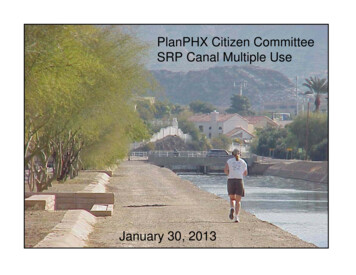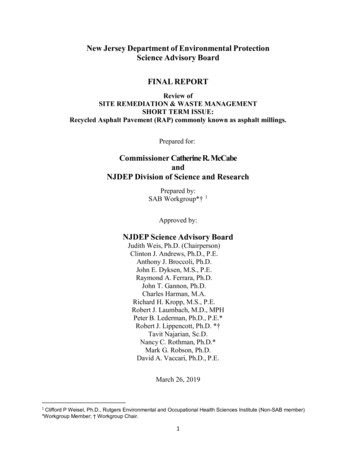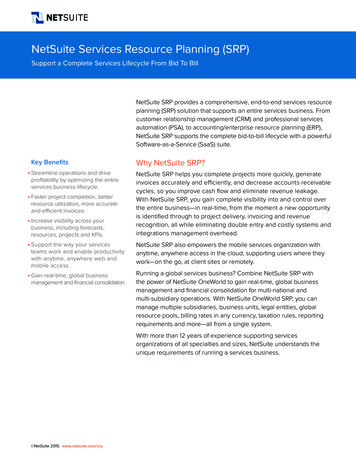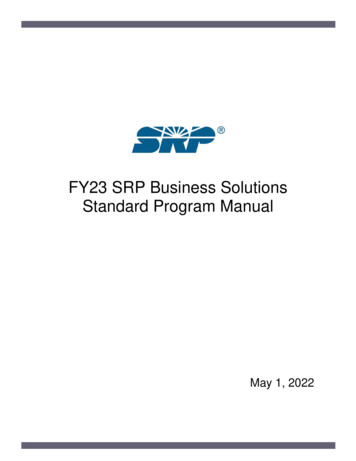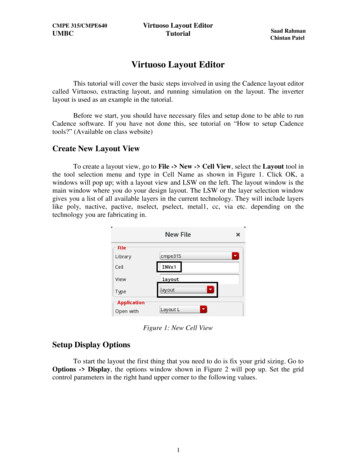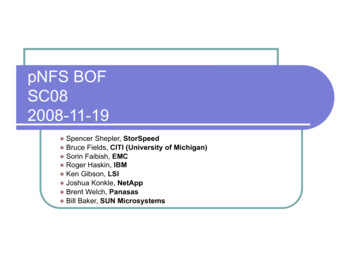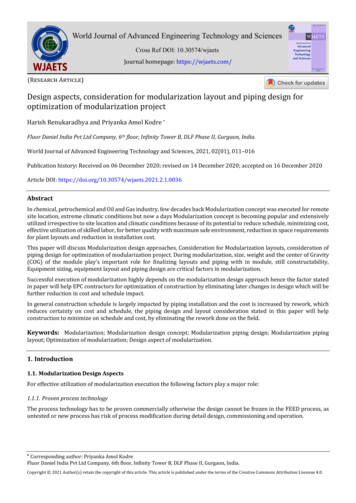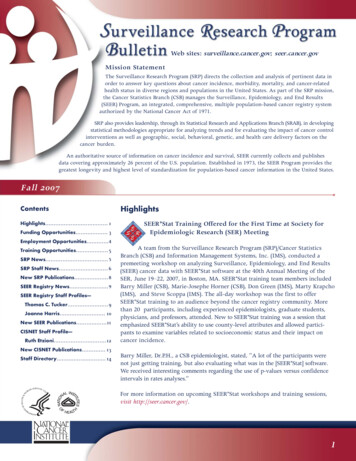
Transcription
Web sites: surveillance.cancer.gov; seer.cancer.govMission StatementThe Surveillance Research Program (SRP) directs the collection and analysis of pertinent data inorder to answer key questions about cancer incidence, morbidity, mortality, and cancer-relatedhealth status in diverse regions and populations in the United States. As part of the SRP mission,the Cancer Statistics Branch (CSB) manages the Surveillance, Epidemiology, and End Results(SEER) Program, an integrated, comprehensive, multiple population-based cancer registry systemauthorized by the National Cancer Act of 1971.SRP also provides leadership, through its Statistical Research and Applications Branch (SRAB), in developingstatistical methodologies appropriate for analyzing trends and for evaluating the impact of cancer controlinterventions as well as geographic, social, behavioral, genetic, and health care delivery factors on thecancer burden.An authoritative source of information on cancer incidence and survival, SEER currently collects and publishesdata covering approximately 26 percent of the U.S. population. Established in 1973, the SEER Program provides thegreatest longevity and highest level of standardization for population-based cancer information in the United States.F all 2007ContentsHighlights. 1Funding Opportunities. 3HighlightsSEER*Stat Training Offered for the First Time at Society forEpidemiologic Research (SER) MeetingEmployment Opportunities.4Training Opportunities. 5SRP News. 5SRP Staff News. 6New SRP Publications. 8SEER Registry News.9SEER Registry Staff Profiles—Thomas C. Tucker. 9Joanne Harris. 10New SEER Publications.11CISNET Staff Profile—Ruth Etzioni.12A team from the Surveillance Research Program (SRP)/Cancer StatisticsBranch (CSB) and Information Management Systems, Inc. (IMS), conducted apremeeting workshop on analyzing Surveillance, Epidemiology, and End Results(SEER) cancer data with SEER*Stat software at the 40th Annual Meeting of theSER, June 19–22, 2007, in Boston, MA. SEER*Stat training team members includedBarry Miller (CSB), Marie-Josephe Horner (CSB), Don Green (IMS), Marty Krapcho(IMS), and Steve Scoppa (IMS). The all-day workshop was the first to offerSEER*Stat training to an audience beyond the cancer registry community. Morethan 20 participants, including experienced epidemiologists, graduate students,physicians, and professors, attended. New to SEER*Stat training was a session thatemphasized SEER*Stat’s ability to use county-level attributes and allowed participants to examine variables related to socioeconomic status and their impact oncancer incidence.New CISNET Publications. 13Staff Directory. 14Barry Miller, Dr.P.H., a CSB epidemiologist, stated, ”A lot of the participants werenot just getting training, but also evaluating what was in the [SEER*Stat] software.We received interesting comments regarding the use of p-values versus confidenceintervals in rates analyses.”For more information on upcoming SEER*Stat workshops and training sessions,visit http://seer.cancer.gov/.1
E-Path Software Discussed at 2007 NAACCRConferenceDuring the North American Association of Central CancerRegistries (NAACCR) Annual Meeting June 2–9, 2007, twosessions on electronic pathology (E-Path) were held. CarolKosary, M.A., a CSB mathematical statistician presented anoverview of the potential uses of electronic sources suchas E-Path in cancer surveillance as used in SEER*DMS andthrough the Hawaii Tumor Registry’s interfacing of E-Pathfor managing its residual tissue repository specimens.”The sessions allowed us to discuss E-Path conceptually,”commented Kosary, ”and to analyze E-Path as a model forelectronic reporting, as well as the next logical steps inmoving beyond E-Path, such as future expansion to otherelectronic record types, including diagnostic imaging,hematology, medical, or surgical records.”Designed by the software engineering firm ArtificialIntelligence in Medicine (AIM), E-Path provides asolution for the automated electronic submission ofpathology reports, especially for rapid case ascertainmentand case-finding by central cancer registries. Since 2004,NCI’s SEER Program and AIM have been collaboratingto install E-Path within all SEER registries. Currently,more than 100 installations are in various states ofcompletion.NPCR and SEER Hold First Hematopoietic andLymphoid Diseases ConferenceThe Centers for Disease Control and Prevention’s (CDC)National Program of Cancer Registries (NPCR) and NCI’sSEER Program held a conference on current issues inhematopoietic and lymphoid diseases July 9–11, 2007, atthe Atlanta Perimeter Center Marriott in Atlanta, GA. As aCDC/NCI joint effort, the 3-day conference was the first ofits kind to bring together in one setting world-renownedhematopathologists, researchers, clinical oncologists, cancerregistry experts, epidemiologists, informatics specialists,and public health administrators. SRP staff members inattendance included Peggy Adamo, R.H.I.T., C.T.R., LoisDickie, C.T.R., Carol Johnson, C.T.R., Denise Lewis, Ph.D.,M.P.H., and Lynn Ries, M.S.2In consideration of the new classification system of lymphoidneoplasms for epidemiologic research proposed by theInternational Lymphoma Epidemiology Consortium(InterLymph) and the forthcoming release of the 2008World Health Organization (WHO) Classification of Tumorsof Hematopoietic and Lymphoid Tissues, the goals for theconference were to: (1) understand the lymphatic andimmune systems from a cancer surveillance standpoint;(2) understand and discuss current issues regarding theclassification and reporting of lymphatic and hematopoieticdiseases; and (3) begin developing a model to identify,capture, and code these diseases identified from any locationat which they may be diagnosed and/or treated.”The sessions helped identify areas in need of additionalattention and resources and provided opportunities towork together to address the needs of the community,”stated Steve Peace, C.T.R., Senior Study Director at Westat.”The hematopoietic and lymphoid diseases represent oneof the most rapidly evolving areas in cancer research,”continued Peace.”The outcome of this meeting will be used to inform theactivities of the SEER hematopoietics workgroup,” statedDenise Lewis, an NCI epidemiologist. ”There was good brainstorming and discussion on issues facing C.T.R.s in centraland hospital registries. Physicians also were made aware ofthe issues and provided valuable input,” commented LoisDickie, public health analyst.Cancer Statistics ReviewThe SEER Cancer Statistics Review (CSR) is an annualreport of the most recent cancer incidence, mortality,survival, prevalence, and lifetime risk statistics. Publishedby NCI’s CSB, this year’s report provides statistics from1975–2004, the most recent year for which data are available.It includes information on more than 7 million cancercases diagnosed between 1973 and the end of the 2004diagnosis year. Through the CSR search function, userscan extract and group pages to create customized PDFfiles. Links also are provided at http://seer.cancer.gov toaccess specific tables and graphs in the CSR.Ries LAG, Melbert D, Krapcho M, Mariotto A, Miller BA, Feuer EJ,Clegg L, Horner MJ, Howlader N, Eisner MP, Reichman M, EdwardsBK (eds). SEER Cancer Statistics Review, 1975-2004, National CancerInstitute. Bethesda, MD, http://seer.cancer.gov/csr/1975 2004/.
Updates to State Cancer Profiles Web SiteThe State Cancer Profiles Web site, http://statecancerprofiles.cancer.gov, which provides dynamic views of cancer statisticsused in prioritizing cancer control efforts, was updated inJuly 2007 to include the latest incidence, mortality, andrisk-factor data. This update included new incidence datafor diagnosis year 2003, provided by CDC’s NationalProgram of Cancer Registries Cancer Surveillance System(NPCR-CSS) from data originally submitted to NPCR inJanuary 2006. Incidence data for diagnosis year 2004,submitted to NCI’s SEER Program in November 2006, alsowas added. From CDC’s National Vital Statistics System,new mortality data were provided to update death datathrough 2004. New 2005 and 2006 Behavioral Risk FactorSurveillance System (BRFSS) data were included as well.New MonographsAssessment of Measures of HealthDisparities MonographThis report provides an empiricalanalysis of the performance andsuitability of potential measuresused to monitor and measure progresstoward eliminating health disparities in cancer-relatedhealth outcomes. It complements a previous monograph thatevaluated measures of health disparity on theoreticalgrounds. This new monograph presents results from 22separate analyses in 10 case studies of trends in selectedcancer-related health disparities. Included are assessmentsof socioeconomic, race, ethnic, and geographic disparitiesin a selected range of cancer-related outcomes, such asmortality, incidence, risk factors, and screening. Themonograph examines the consistency of health-disparitymeasures across cancer-related outcomes and sheds lighton the implications of choosing different disparity measures to analyze the same data for monitoring progress towardreducing health disparities.Harper S, Lynch J. Selected Comparisons of Measures of HealthDisparities Using Databases Containing Data Relevant to HealthyPeople 2010 Cancer-Related Goals. NCI Cancer SurveillanceMonograph Series, Number 7. National Cancer Institute. NIHPub. No. 07-6281. Bethesda, MD, 2007.To be released in November 2007,at www.seer.cancer.gov/publications.SEER Cancer Survival MonographThis monograph examines cancerpatient survival as influenced bypatient and tumor characteristics forcancers diagnosed during the period1988–2001 in the SEER geographicareas covering approximately onefourth of the U.S. population. Eachchapter covers a distinct anatomicalsite and/or histologic types. The monographpresents descriptive analyses of cancer survival rates andprovides detailed information to the medical communityconcerned with prognosis.Available October 28, 2007,at www.seer.cancer.gov/publications.Funding OpportunitiesCancer Control GrantsNCI’s Division of Cancer Control and Population Sciences(DCCPS) currently funds a portfolio of more than 900 grantsand contracts. A wide range of research is supported,including in surveillance, epidemiology, behavioral science,health promotion, dissemination and diffusion, and cancersurvivorship. Future funding opportunities may be viewedat rch Supplements to Promote Diversity inHealth-Related ResearchIn an effort to promote diversity in the research community,funding is available for administrative supplements to NIHresearchers who support and recruit fellow researchers fromunderrepresented racial and ethnic groups. For more information, visit http://dccps.nci.nih.gov/funding minority.html.3
Employment OpportunitiesNCI is inviting applications for several positions within SRP,DCCPS. Candidates for all positions must demonstrate a strongrecord of analytical and methodological research and scientificcollaboration. U.S. citizenship or permanent residency isrequired for federal positions. The U.S. Department of Healthand Human Services (HHS) and NIH are equal opportunityemployers. Salary is commensurate with experience, and thepositions are located in Rockville, MD, near Washington, DC.For each position, send a letter summarizing your experienceand interests and a complete CV, including the names ofthree references, by electronic mail to the listed contact.Position in Spatial StatisticsSRP has an active program of research in the statistical analysis ofspatial and temporal patterns of cancer, spatial data visualization, and Geographic Information Systems (GIS)(http://gis.cancer.gov/). Opportunities exist for collaboration andleadership in the areas of spatial statistics and geographicallyrelated analysis throughout NCI and with other NIH Institutes,other federal agencies, and the extramural research community.Requirements: A Ph.D. in biostatistics or a related field andexperience in spatial statistical methods applications andresearch, with an emphasis on model-based methods.Experience in one or more of the following areas also isdesirable: disease-rate mapping, geovisualization, GIS,and cancer registry data analysis.Contact: Eric J. (Rocky) Feuer, Ph.D., Chief, StatisticalResearch & Applications Branch, rf41u@nih.govPositions in Mathematical Statistics andBiostatisticsNCI has several positions available within the SEER Program.Each position includes responsibility for initiating andmanaging collaborative analyses with scientists from NCIand other Institutes, agencies, and academic centers.Current openings include Senior Mathematical Statistician(minimum 4 years’ postdoctoral experience) and Biostatistician(minimum 2 years’ postdoctoral experience).Contact: Judith Swan, M.H.S., Surveillance ResearchProgram, js60y@nih.gov4Quantitative Epidemiologist/Social ScientistSRP is inviting applications for a quantitative epidemiologist/social scientist with a focus on social correlates of cancer. Theposition focuses on utilization of novel measures of health disparities, examination of individual versus ecologic measuresof socioeconomic status, and/or geospatial analysis.Requirements: A graduate degree and several years’experience related to the study of health disparities.Contact: Judith Swan, M.H.S., Surveillance ResearchProgram, js60y@nih.govFellowship and Sabbatical Positions in CancerSurveillance ResearchSRP invites applications from qualified candidates in thearea of cancer surveillance research. The positions rangefrom summer-only to 1-year appointments. Successfulcandidates will come into contact with scientists and publichealth professionals representing a variety of researchdisciplines. Mechanisms include the Cancer ResearchTraining Award (CRTA) and the IntergovernmentalPersonnel Act (IPA) sabbatical position.Contact: Dr. Ram Tiwari, Statistical Research andApplications Branch, tiwarir@mail.nih.govFor further information on all positions, cer.gov/http://srab.cancer.gov/
Training Opportunities2008 NCRA Annual ConferenceThe National Cancer Registrars Association (NCRA) willhold its 34th annual conference April 27–30, 2008, inMinneapolis, MN. For more information on this meeting,including on registering for the program and presentingposters, visit http://www.ncra-usa.org/conference/.2008 NAACCR Annual ConferenceThe 2008 North American Association ofCentral Cancer Registries (NAACCR)Annual Conference will be held June9–12, 2008, in Denver, CO, at the GrandHyatt Denver. Further information on the conference program and registration may be found on the NAACCR Website at http://www.naaccr.org.2008 SER Annual MeetingThe 41st Annual Meeting of the Society for EpidemiologicResearch (SER) is scheduled for June 24–27, 2008, in Chicago,IL. For further information, visit http://www.epiresearch.org.MP/H Coding Rules Online Breeze Web Castingcolon, lung, and urinary cancer sites through the NCISEER Program’s new online training sessions, titled”Beyond the Basics.” Problems registrars have encounteredusing the rules are clarified and addressed. The sessions,complete with transcripts, cases, answers and rationale,and continuing education certificates, are accessiblethrough the SEER Web site at http://www.seer.cancer.gov/tools/mphrules/training advanced.html. For training on thebasics of MP/H coding rules, registrars can continue to accessonline training sessions, titled ”The Fundamentals,” ng basics.html,which covers head and neck, lung, colon, breast, urinary,melanoma, kidney, brain, and other cancer sites. ContactAntoinette Percy-Laurry at percyl@mail.nih.gov withquestions regarding this training.Principles of Oncology Training Program inCancer Registry Operations and ProceduresA. Fritz and Associates is offering a 5-day trainingprogram in cancer registry operations and proceduresentitled ”Principles of Oncology,” December 10–14, 2007,in Reno, NV. The course is endorsed by the NCRA andNAACCR and recommended by NCI’s SEER Program.The registration fee for the program is 949. For moreinformation, including registration procedures and adaily class schedule, visit http://www.afritz.org/pocr.htm.Registrars can find advanced training on the 2007 MultiplePrimary and History (MP/H) Coding Rules covering breast,SRP NewsCISNET Grantees Awarded Dissemination andDiffusion SupplementIn August 2007, two Cancer Intervention and SurveillanceModeling Network (CISNET) grantees were approved forfunding under the Dissemination and Diffusion ofSurveillance Research supplements. A supplement wasawarded to Jeanne Mandelblatt, M.D., M.P.H., ofGeorgetown University, Washington, DC, for her existingCISNET grant, titled ”The SPECTRUM of Breast CancerDisparities.” This supplement, which will be led byco-Principal Investigator Michael Stoto, Ph.D., also ofGeorgetown University, will support the dissemination ofa simulation to determine theexpected effects of changes inscreening, risk factors, and treatment on predicted breast cancermortality of women in the DC area.The second supplement was awarded to David Levy, Ph.D., from thePacific Institute for Research &Michael Stoto, Ph.D.Evaluation in Calverton, MD, forhis current CISNET grant, titled ”A Simulation of TobaccoPolicy, Smoking, and Lung Cancer.” This supplement willsupport the dissemination of SimSmoke, a dynamic computercontinued on page 65
continued from page 5information. DCCPS anticipatesreleasing a similar notice for applications in FY08, which will be circulated to SRP grantees and posted on the SRP and DCCPS Websites. For more information, contact Emily Dowling atdowlinge@mail.nih.gov.simulation model to track changes in smoking behavior andmortality for policymakers and health advocates. Thesimulation model will assess the effect of tobacco controlpolicies in reducing smoking-related morbidity andmortality in Kentucky.This is the second year that DCCPS has supported supplements for the dissemination and diffusion of surveillanceSRP Staff NewsKevin Dodd, Ph.D., Moves to DCPKevin Dodd, Ph.D., a MathematicalStatistician in SRAB since 1999, leftSRP to join the Biometry ResearchGroup of NCI’s Division of CancerPrevention (DCP). In his newposition, Dr. Dodd will continuehis work in the field of dietaryassessment and measurementerror. He also will serve as the DCPrepresentative to the Nutrition andKevin Dodd, Ph.D.Behavior subcommittee, part of theProstate, Lung, Colorectal, and Ovarian Cancer ScreeningTrial (PLCO). Dr. Dodd received his Ph.D. from Iowa StateUniversity in 1999.Steve Meersman, Ph.D., Moves to Rhode IslandDepartment of HealthIn April 2007, Stephen C. Meersman,Ph.D., moved to a new position asthe Provision of Care ProgramManager at the Office of HIV/AIDSand Viral Hepatitis at the RhodeIsland (RI) Department of Health.In this position, Dr. Meersmanwill oversee the RI AIDS DrugAssistance Program (ADAP), apharmacy benefit program conStephen C. Meersman,Ph.D.ducted in accordance with theRyan White CARE Act to help low-income, uninsured, and6David Levy, Ph.D.underinsured HIV/AIDS-affected populations. Dr. Meersmanalso will coordinate Title II services and affiliated programs.This includes providing community-based and statewideHIV/AIDS support services.Dr. Meersman worked at SRP for 2 years developing aresearch agenda to integrate surveillance data from theSEER Program and ecological databases to address socialdeterminants of cancer health disparities. Serving asliaison between SRP and the wider NCI community, Dr.Meersman chaired both the Health Disparities SeminarSeries and the DCCPS Health Disparities Interest Group.AwardsBill Davis, Ph.D., Receives SPAIG AwardWilliam Davis, Ph.D., an SRABmathematical statistician, wasawarded the Statistical Partnershipsamong Academe, Industry andGovernment (SPAIG) award fromthe American Statistical Association(ASA), an NCI collaboration thatincludes the biostatistics departments of the University ofWilliam Davis, Ph.D. (right), Michigan and the University ofwith ASA PresidentPennsylvania, CDC’s NationalMary Ellen BockCenter for Health Statistics andthe Behavioral Surveillance Branch of the National Centerfor Chronic Disease Prevention and Health Promotion, andInformation Management Systems, Inc. (IMS). NCI begancontinued on page 7
continued from page 6the project for which Dr. Davis received the award inresponse to the challenge of determining how informationfrom multiple surveys can be combined to provide single,small-area estimates of cancer risk factors and cancerscreening behavior. In addressing this challenge, Dr. Davisrecognized the complementary strengths of moderate-size,in-person surveys with high response rates and large RDDsurveys with moderate response rates. ”We’ve been working with other academic and government researchers on thisproblem for 6 years now. It is gratifying to see our effort recognized through a national award from the most prominentU.S. statistical association. I’d like to take complete credit,but I’ve just been a good team player,” stated Dr. Davis.The award was presented July 31, 2007, in Salt Lake City,UT, at the Presidential Address Session during ASA’sAnnual Meeting. For information on future ASA meetings,visit http://www.amstat.org.Xihong Lin, Ph.D., Receives NCI MERIT AwardIn June 2007, Xihong Lin, Ph.D.,professor of Biostatistics at HarvardUniversity and member of theDana-Farber Cancer Institute,received NCI’s MERIT Award forwork on her grant, ”StatisticalMethods for Correlated and HighDimension Biomedical Data.” Dr.Lin’s project proposes to developXihong Lin, Ph.D.advanced statistical informaticsmethods for high-dimensional genomic data in populationstudies, such as gene (SNP) selection, joint effects of genesin a genetic (metabolic) pathway, gene-gene (SNP-SNP)interactions, and gene-environment interactions. Dr. Linexpressed her gratitude to NCI for this coveted award andadded that, ”with the rapid progression of biotechnologyand genomics, quantitative research such as biostatisticsand computer sciences becomes increasingly critical inadvancing modern health sciences research. This MERITaward will allow me to focus better on advancing the fieldand develop a long-term plan by working closely withhealth sciences researchers.”Dr. Lin received her Ph.D. in biostatistics from the Universityof Washington in 1994 and has published more than 90 articlesin peer-reviewed journals. Dr. Lin also serves as PrincipalInvestigator for two NCI-funded conference grants thataddress statistical issues in biomedical and cancer research.New HiresMonica Jackson, Ph.D., Joins SRPMonica Jackson, Ph.D., joined SRABas a mathematical statistician in May2007 under the IntergovernmentalPersonnel Act (IPA). Dr. Jacksoncomes to SRP on sabbatical fromAmerican University (AU). Shereceived a Ph.D. in applied mathematics and scientific computationand completed her thesis, ”SpatialMonica Jackson, Ph.D.Data Analysis for Discrete Data ona Lattice” at the University of Maryland. She obtained herB.S. in mathematics and M.S. in applied mathematics fromClark Atlanta University in Atlanta, GA. Dr. Jackson alsoworked at Emory University as a postdoctoral researcherin biostatistics. Currently, she serves as assistant professorof statistics in AU’s Department of Mathematics andStatistics. Her credentials include publications inContemporary Mathematics, Encyclopaedia of Environmetrics,and Geographical Analysis, and numerous invited lecturesthroughout the United States. During her sabbatical atSRAB, Dr. Jackson will work on projects in the fields ofspatial data analysis. Despite her busy schedule, Dr.Jackson makes time for other interests such as bowling.She also enjoys swimming and amateur photography,especially portraiture.Leyda Su Ham Joins SRPLeyda Su Ham, D.O., M.P.H., M.B.A, joined SRP as a HealthCommunications Intern through a Cancer Research TrainingAward (CRTA) fellowship in the Office of the AssociateDirector in July 2007. Dr. Su Ham graduated this yearafter being dually enrolled in the Nova SoutheasternUniversity (NSU) College of Osteopathic Medicine andMaster in Public Health Program in Ft. Lauderdale, FL.Her previous experience includes interning at theCaridad Health Center in Boynton Beach, FL, and workingas a graduate research assistant at NSU’s Institute forcontinued on page 87
continued from page 7Child Health Policy. She holds a B.S.in biology and an M.B.A. fromNSU’s Farquhar College of Arts andSciences and H. Wayne HuizengaSchool of Business and Entrepreneurship, respectively. Dr. Su Hamhas strong interests in preventivemedicine, public health administration, and health communications.Leyda Su Ham, D.O.,At SRP, she will be involved inM.P.H., M.B.A.the initiation, development, andproduction of a variety of media, surveillance research,and other health promotion projects. Away from the office,Dr. Su Ham enjoys spending time with her family andfriends, traveling, reading, rollerblading, and Web design.Kimberly Walters Joins SRPKimberly A. Walters joined SRAB in July 2007 as a biostatistician through the CRTA fellowship program. Ms. Waltersis a Ph.D. candidate in biostatistics atThe Ohio State University (OSU) andplans to graduate in June 2008. Ms.Walters has a B.S. in chemistry witha minor in mathematics from theRensselaer Polytechnic Institute inTroy, NY. She has provided statisticalsupport for a National Institute ofMental Health (NIMH)-fundedKimberly Walters, B.S.psychology intervention study andCRTA Fellowis a member of the AmericanStatistical Association, Caucus of Women in Statistics, andMensa. Ms. Walters made a presentation on ”GivingTreatment to Controls: When Is It a Good Idea?” at the2007 Joint Statistical Meeting in Salt Lake City, UT. As aCRTA fellow for the summer term, Ms. Walters worked withDr. Ram Tiwari on cancer surveillance research projects. Oneof these projects was a paper, ”Comparing Age-AdjustedRates in Overlapping Regions or Time Intervals.” In herspare time, she enjoys contemporary fiction, books on CD,aerobics, Pilates, yoga, and listening to National PublicRadio.New SRP PublicationsClegg LX, Reichman ME, Hankey BF, Miller BA, Lin YD, JohnsonNJ, Schwartz SM, Bernstein L, Chen VW, Goodman MT, Gomez SL,Graff JJ, Lynch CF, Lin CC, Edwards BK. Quality of race, Hispanicethnicity, and immigrant status in population-based cancer registrydata: implications for health disparity studies. Cancer CausesControl. 2007 Mar;18(2):177-87. Epub 2007 Jan 11.Cronin-Fenton DP, Ries LA, Clegg LX, Edwards BK. Rising incidence rates of breast carcinoma with micrometastatic lymph nodeinvolvement. J Natl Cancer Inst. 2007 Jul 4;99(13):1044-9. Epub2007 Jun 27.Graubard, BI, Hartman AM, Gilpin EA, Murray DM, Stillman FA.Contributors: Gibson JT, Davis W. Chapter 9. Final outcomes: analytical methods and results. In: National Cancer Institute.Evaluating ASSIST: A Blueprint for Understanding State-levelTobacco Control. Tobacco Control Monograph No. 17. Bethesda,MD: U.S. Department of Health and Human Services, NationalInstitutes of Health, National Cancer Institute. NIH Pub. No. 066058, October 2006.8Mariotto AB, Etzioni R, Krapcho M, Feuer EJ. Reconstructing PSAtesting patterns between black and white men in the United Statesfrom Medicare claims and the National Health Interview Survey.Cancer. 2007 May 1;109(9):1877-86.Mariotto AB, Rowland JH, Ries LA, Scoppa S, Feuer EJ. Multiplecancer prevalence: a growing challenge in long-term survivorship.Cancer Epidemiol Biomarkers Prev. 2007 Mar;16(3):566-71.Ravdin PM, Cronin KA, Howlader N, Berg CD, Chlebowski RT,Feuer EJ, Edwards BK, Berry DA. The decrease in breast cancerincidence in 2003 in the United States. N Engl J Med. 2007 Apr19;356(16):1670-4.Yu B, Barrett MJ, Kim HJ, Feuer EJ. Estimating joinpoints in continuous time scale for multiple change-point models. Comput Stat DataAnnal. 2007 Feb 1;51(5):2420-7.
SEER Registry News2007 SEER Manager and PI MeetingThe 2007 SEER Program Managers and PrincipalInvestigators (PI) Meetings will be held November 7–9,2007, at the Neuroscience Building located at 6001Executive Boulevard, Rockville, MD. Individuals fromNCI’s DCCPS and SEER’s 18 cancer registries are invited todiscuss issues in cancer surveillance. For more information,visit http://www.scgcorp.com/seerpi2007, or contact BetsyFlagg at eflagg@mail.nih.gov.SEER Data Name ChangeKentucky Deploys Web-Based GIS System forCancer Incidence and Mortality DataSince August 2002, the Kentucky Cancer Registry (KCR),a SEER registry, has provided a Web-based geographicinformation system (GIS) for state and local cancer data,hosted at http://cancer-rates.info. Users can publicly access andquery cancer incidence and mortality data using selectablecriteria such as geography, cancer site, and diagnosisyear(s). NCI recently provided funding to add the SEERregistries of Iowa, Connecticut, New Mexico, Hawaii, andSeattle to the Web site. New Jersey SEER registry datahave been available on cancer-rates.info since 2004.With the latest SEER Data for the years 1973–2004 releasedin April 2007, the SEER ”Public Use” file has been renamedthe SEER ”Limited Use” file. The change is in name onlyand reflects the fact that users always have been requiredto sign and abide by a data-use agreement to guaranteeconfidentiality. It also corresponds with legislativerequirements and privacy-protection practices that ensureuser awareness of the responsibilities involved when usingthe data. Researchers should rest assured that the namechange does not affect any procedures and th
(SEER) cancer data with SEER*Stat software at the 40th Annual Meeting of the SER, June 19-22, 2007, in Boston, MA. SEER*Stat training team members included Barry Miller (CSB), Marie-Josephe Horner (CSB), Don Green (IMS), Marty Krapcho (IMS), and Steve Scoppa (IMS). The all-day workshop was the first to offer
